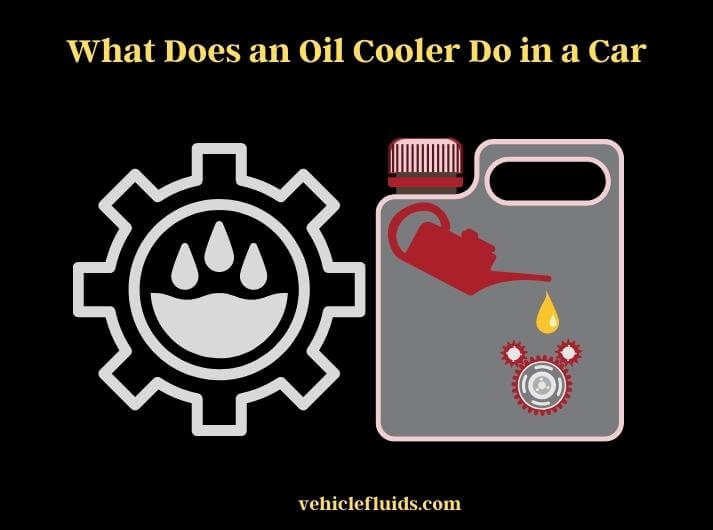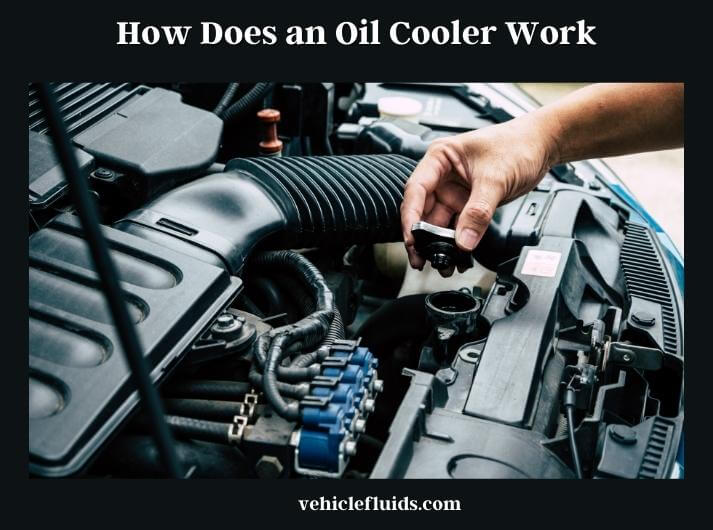The oil cooler is an essential component of a car’s engine, and it is responsible for maintaining the temperature of the oil used to lubricate and cool down the engine. Without an oil cooler, the engine would overheat and break down. An oil cooler helps to reduce the temperature of the oil, and this keeps the engine running at optimal temperatures.

The oil cooler works by cooling down the oil when it passes through the radiator and then returns it to the engine. This helps to ensure the proper lubrication of the engine and to prevent overheating. The oil cooler also helps to reduce the amount of oil that needs to be added to the engine, thus reducing the costs associated with oil changes. An oil cooler is a vital component of any car, and it is regularly maintained and serviced to ensure that it is functioning properly.
What is an Oil Cooler?
An oil cooler is a device used to cool down the oil in a car’s engine. It works by running engine oil through a series of tubes, which are cooled by air or liquid. By reducing the temperature of the oil, an oil cooler helps to prevent engine damage and improves the car’s overall performance.
A transmission oil cooler is an additional device that helps keep your transmission cool and working efficiently.
How Does an Oil Cooler Work?
When an engine runs, it generates a lot of heat, which can cause the oil to break down and lose its lubricating properties. This can lead to premature wear and tear on the engine components, reducing their lifespan.
An oil cooler works by dissipating the heat generated by the engine. It does this by circulating engine oil through a set of tubes or fins, which are designed to maximize heat transfer. As the oil flows through these tubes or fins, it is exposed to a cooling medium, such as air or liquid, which helps to lower its temperature.

The cooled oil is then circulated back into the engine, where it can continue to lubricate and protect the engine components. By reducing the temperature of the oil, an oil cooler helps to prevent engine damage and improve the overall performance of the car.
Types of Oil Coolers
There are two main types of oil coolers used in cars:
- Air-Cooled and
- Liquid-Cooled.
Air-Cooled:
Air-cooled oil coolers are the most common type and work by using air to cool the engine oil. They typically consist of a set of tubes or fins, which are exposed to the airflow created by the car’s motion. This airflow helps to dissipate the heat generated by the engine and reduce the temperature of the oil.
Liquid-Cooled:
Liquid-cooled oil coolers, on the other hand, use a liquid, such as a coolant or water, to cool the engine oil. They work by circulating the oil through a set of tubes or fins, which are cooled by the liquid. The cooled oil is then returned to the engine, where it can continue to lubricate and protect the engine components.
Engine coolant is an essential component that helps to prevent the engine from overheating, lubricates engine components and prevents corrosion and rust in the cooling system.
Why Do Cars Need Oil Coolers?
Cars need oil coolers because they help to regulate the temperature of the engine oil. The engine oil in a car performs several critical functions, including lubrication, cleaning, and cooling. The high temperatures generated by the engine can cause the oil to break down, leading to a decrease in its effectiveness.
An oil cooler helps to dissipate the heat generated by the engine, keeping the engine oil at an optimal temperature. This not only helps to improve the effectiveness of the oil but also prevents the engine from overheating. Overheating can cause significant damage to the engine and lead to costly repairs.
Oil cooling is particularly important in high-performance vehicles that generate a lot of heat due to their high speeds and intense use. Without an oil cooler, the engine oil in these vehicles may not be able to dissipate heat quickly enough, leading to premature wear and tear on the engine components.
How to Install an Oil Cooler in Your Car?
Installing an oil cooler in your car can help to prevent engine overheating and extend engine lifespan. Here are the steps to install an oil cooler in your car:
Choose the Right Oil Cooler:
There are several types of oil coolers available in the market. Choose an oil cooler that is compatible with your car’s engine and can handle the amount of heat generated by the engine.
Determine the Location of Installation:
The oil cooler should be installed in a location where it can receive adequate airflow for cooling. A popular location is in front of the radiator where it can receive cool air. You may also need to make sure that there is enough space to mount the oil cooler.
Gather the Tools Required:
You will need a socket wrench set, screwdrivers, pliers, and other basic tools.
Drain the Engine Oil:
Before installing the oil cooler, drain the engine oil and remove the oil filter.
Install the Oil Cooler:
Mount the oil cooler in the chosen location using the provided brackets and fasteners. Connect the oil cooler to the engine oil lines using the appropriate fittings. Make sure that the oil cooler is securely mounted and does not interfere with any other components.
Install the Oil Filter Adapter:
Install the oil filter adapter that came with the oil cooler kit. Connect the oil lines from the engine to the adapter.
Refill the Engine Oil:
Once the oil cooler and adapter are installed, refill the engine with the appropriate amount and type of oil. Check the oil level using the dipstick.
Test the Installation:
Start the engine and let it run for a few minutes. Check for any leaks or abnormal noises. Monitor the engine temperature to ensure that the oil cooler is working correctly.
What Are the Signs of a Faulty Oil Cooler in a Car?
The oil cooler in your car is an essential component that helps to regulate the temperature of the engine oil and prevent overheating. Here are some signs that your car’s oil cooler may be faulty:
- Reduced engine performance: A faulty oil cooler can cause a drop in engine performance, as the engine oil may not be able to cool the engine effectively. You may notice a decrease in acceleration or power.
- Higher engine temperatures: If your car’s engine temperature is higher than normal, it could be a sign of a faulty oil cooler. Overheating can cause engine damage, so it definitely needs to address this issue as soon as possible.
- Low oil pressure: A faulty oil cooler can also cause low oil pressure, which can lead to engine damage if left unchecked. Low oil pressure can cause engine components to wear out more quickly and may cause the engine to seize.
- Oil leaks: If you notice oil spots on the ground or oil stains on the oil cooler’s surface, it could be a sign of a leak in the oil cooler. Oil leaks can cause a drop in oil pressure and reduce the effectiveness of the oil cooler.
If you notice any of these signs, it is important to have your car’s oil cooler checked by a professional mechanic. A faulty oil cooler can cause serious engine damage if left unchecked, so it is important to address any issues as soon as possible.
What are the Benefits of Using an Oil Cooler?
Using an oil cooler in your car can provide several benefits, including:
Improved Engine Performance:
By reducing the temperature of the engine oil, an oil cooler can help to improve the performance of the car. This is because cooler oil is better able to lubricate and protect the engine components, reducing wear and tear and improving overall efficiency.
Extended Engine Life:
Using an oil cooler can also help to extend the life of your car’s engine. By reducing the heat generated by the engine, an oil cooler can help to prevent premature wear and tear on the engine components, helping them to last longer.
Improved Fuel Efficiency:
When an engine runs cooler, it is typically more fuel-efficient. This is because cooler engines require less fuel to operate, as they are not working as hard to generate the same amount of power.
An oil cooler is an essential component of any car’s engine. It helps to reduce the temperature of the oil, which in turn helps to prevent engine damage and improve the overall performance of the car.
Maintenance of Oil Coolers
Maintaining your car’s oil cooler is essential to ensure that it continues to function correctly and efficiently. Here are some tips for maintaining your oil cooler:
Regular Cleaning:
Dirt, debris, and other contaminants can build upon the oil cooler’s surface and reduce its ability to dissipate heat effectively. Regularly clean the oil cooler with a soft-bristled brush and a mild detergent solution. Rinse it thoroughly with water and let it dry completely before reinstalling it.
Inspect for Damage:
Check the oil cooler for any signs of damage, such as cracks, leaks, or bent fins. Damaged oil coolers may not function correctly and could cause engine damage if left unchecked. If you find any damage, replace the oil cooler immediately.
Check for Leaks:
Oil leaks from the oil cooler can cause a drop in oil pressure and lead to engine damage. Check the oil cooler for any signs of leaks, such as oil spots on the ground or oil stains on the oil cooler’s surface. If you find any leaks, repair or replace the oil cooler as soon as possible.
Monitor Engine Temperature:
Keep an eye on your car’s engine temperature gauge regularly. If you notice the engine temperature rising, it could be a sign of a faulty oil cooler. In this case, you should have the oil cooler checked by a professional mechanic.
Replace Oil Cooler Hoses:
Over time, oil cooler hoses can deteriorate and develop cracks or leaks. Inspect the hoses for any signs of damage and replace them if necessary. Make sure that the replacement hoses are compatible with your car’s engine and the oil cooler.
The Bottom Line
An oil cooler is a very important component of a car’s engine. It is responsible for cooling the engine’s oil and keeping it at a constant temperature. This helps to ensure that the engine is running at peak performance and keeps it from overheating.
The oil cooler also helps to extend the life of the engine by preventing the oil from breaking down due to extreme heat. With an oil cooler, car owners can be sure that their car’s engine is running at its best.
